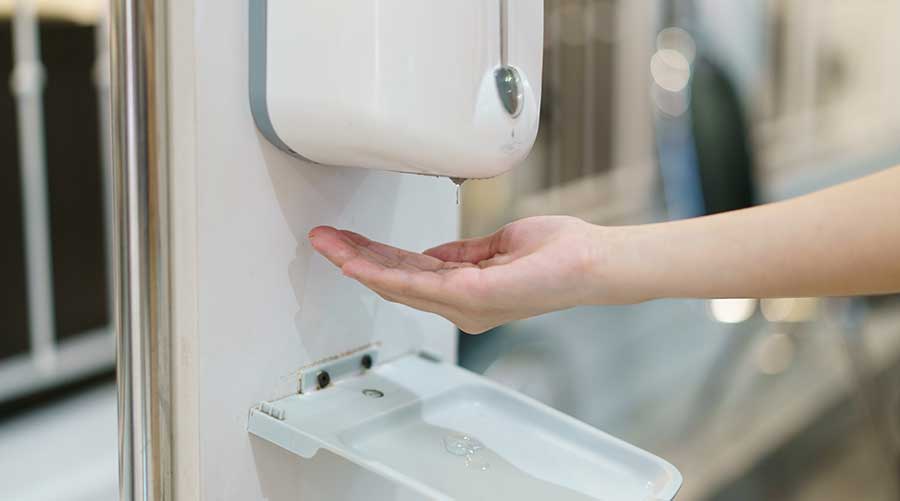Soap dispensers and hand sanitizers are a must for keeping any healthcare facility healthy. However, traditional soap dispensers are operated by hand, and that can lead to germ spread upon contact. Touchless soap dispensers provide a possible fix for that. Similarly, another way of preventing germ spread is through making hand sanitizers available at nursing stations. In this manufacturer roundtable, Healthcare Facilities Today speaks to leading soap manufacturers about if touchless soap dispensers and hand sanitizers at nursing stations are necessary.
Are touchless soap dispensers a must-have in healthcare facilities?
“Delivering hand soap and sanitizer in a way that minimizes contact and reduces contamination is a definite benefit to healthcare facilities. Touchless dispensers offer a truly contactless handwashing/sanitizing experience and prevent cross contamination. Think of all the high-touch surfaces in a workplace: door handles, tables and chairs, pens, light switches, phones, stair rails, elevator buttons – not to mention countless points in patient rooms and restrooms. Utilizing no touch dispensers is one less touchpoint and provides employees, visitors and patrons with the peace of mind knowing the facility cares about health and safety.
Portable hand sanitizing stations require touchless dispensers and are ideal for locations where soap and water aren’t accessible including entrances and exits, lobbies, hallways, break rooms and other high-traffic areas.”
—Brandon Jones, vice president of sales and marketing, Kutol Products
“Touch-free hand soap or hand sanitizer dispensers offer high convenience and ease of use factors that busy healthcare workers appreciate. Being able to quickly get the right amount of product needed to clean your hands effectively every time helps keep medical staff focused on what matters – providing safe patient care.”
—Jaimee Rosenthal, director of U.S. healthcare markets, GOJO Industries
Should healthcare facilities have hand sanitizers at nursing stations?
“Absolutely. We know when facilities make hand sanitizer available in areas like nursing stations, usage increases. With increased usage, more germs are killed and less illness spreads. It’s a win-win for healthcare staff, patients as well as the facility.
Beyond nursing stations, hand sanitizer should be made available in all common areas and in areas where patient care is being delivered. Pump gallons, floor and countertop stands, and small, portable bottles are a few packaging options that help accommodate placement throughout healthcare facilities. Additionally, the Centers for Disease Control and Prevention recommends placing alcohol-based hand sanitizer in every patient room (at the entrance or bedside) as well as providing healthcare workers with individual, pocket-sized containers.”
—Brandon Jones, vice president of sales and marketing, Kutol Products
“Ensuring access to hand hygiene supplies, including alcohol-based hand rub (ABHR), is an essential practice foundational to all infection prevention programs. The Society for Healthcare Epidemiology of America (SHEA) recently updated it compendium of strategies to prevent healthcare associated infections through hand hygiene and emphasized the importance of making ABHR visible and available within the workflow of healthcare workers (HCW). At a minimum, dispensers should be placed in the hallway outside of the patient’s room and inside the patient room, but beyond that, at nurse’s stations, near elevators, in check-in areas, and other areas that make it easy for HCWs as they often cite access to product as the primary barrier for compliance.”
—Megan J. DiGiorgio, senior clinical manager, GOJO Industries
Jeff Wardon, Jr. is the assistant editor for the facilities market.

 UF Health Hospitals Rely on Green Globes to Realize Their Full Potential
UF Health Hospitals Rely on Green Globes to Realize Their Full Potential How Healthcare Facilities Can Be Truly Disaster-Resilient
How Healthcare Facilities Can Be Truly Disaster-Resilient TriasMD Breaks Ground on DISC Surgery Center for San Fernando Valley
TriasMD Breaks Ground on DISC Surgery Center for San Fernando Valley Bigfork Valley Hospital Falls Victim to Data Breach
Bigfork Valley Hospital Falls Victim to Data Breach AI-Driven Facilities: Strategic Planning and Cost Management
AI-Driven Facilities: Strategic Planning and Cost Management